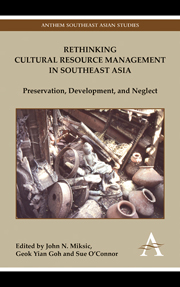Book contents
- Frontmatter
- Contents
- List of Tables and Figures
- Introduction: John N. Miksic
- Southeast Asia (General)
- East Timor
- Cambodia
- Chapter 5 Rethinking Cultural Resource Management: The Cambodian Case
- Chapter 6 Conservation of the Thnal Mrech Kiln Site, Anlong Thom, Phnom Kulen
- Chapter 7 Cultural Resource Management in Phnom Sruk: Potential and Problems
- Chapter 8 Archaeology and Cultural Resource Management South of Phnom Penh, Cambodia
- Chapter 9 Heritage Management of Wooden Prayer Halls in Battambang Province, Cambodia
- Myanmar
- The Philippines
- Singapore
- Vietnam
Chapter 7 - Cultural Resource Management in Phnom Sruk: Potential and Problems
from Cambodia
Published online by Cambridge University Press: 05 May 2012
- Frontmatter
- Contents
- List of Tables and Figures
- Introduction: John N. Miksic
- Southeast Asia (General)
- East Timor
- Cambodia
- Chapter 5 Rethinking Cultural Resource Management: The Cambodian Case
- Chapter 6 Conservation of the Thnal Mrech Kiln Site, Anlong Thom, Phnom Kulen
- Chapter 7 Cultural Resource Management in Phnom Sruk: Potential and Problems
- Chapter 8 Archaeology and Cultural Resource Management South of Phnom Penh, Cambodia
- Chapter 9 Heritage Management of Wooden Prayer Halls in Battambang Province, Cambodia
- Myanmar
- The Philippines
- Singapore
- Vietnam
Summary
Introduction
This chapter examines cultural and ecological resources found in northwestern Cambodia. These resources are not well developed or systematically managed. This chapter provides a template for development of the region based on its agricultural potential and cultural resources which might benefit the whole province of Banteay Mean Chey.
Background
Phnom Sruk is the name of a district and also the main town in the province of Banteay Mean Chey, northwestern Cambodia. In this chapter, Phnom Sruk will be used to refer to the town, which is a moated complex covering 1 square kilometer. Ancient highways, hydraulic features, temple sites, prehistoric sites, a bird sanctuary, and agriculture are the main features of Phnom Sruk. A systematic approach to the management of the potential presented by these resources particularly the cultural ones would benefit the local economy and decrease looting activities currently taking place in most archaeological sites.
Phnom Sruk is approximately 70km northwest of the great monumental complex and major tourist site of Angkor, and 300km northwest of the nation's capital at Phnom Penh. Tonlé Sap Lake lies 20km to the south, while the Dangrek mountain range is a similar distance to the north. During the rainy season waters from the Tonlé Sap (“Great Lake”) and mountains flood the lowland. The Stueng Sreng River flows from the Dangrek mountains to the Great Lake, 15km east of the town.
- Type
- Chapter
- Information
- Rethinking Cultural Resource Management in Southeast AsiaPreservation, Development, and Neglect, pp. 117 - 122Publisher: Anthem PressPrint publication year: 2011

